Yesterday I wrote a post on the current state of the running shoe market. One of the things that is clear from sales data is that the “lightweight” shoe category is growing rapidly, and is starting to eat away at the traditional neutral-stability-motion control categories. Thus, it comes as no surprise that Asics, who have been slow to embrace the minimalist trend, are now releasing a lightweight (8.6 oz in men’s 9), 6mm drop running shoe called the Asics Gel Lyte33 (see photo below from Running Warehouse).
Asics Gel Lyte33
I suspect it’s doubtful that you will see the word minimalist paired with the Gel Lyte33 (just as Brooks avoided the term in association with its Pure series), and in a post introducing the shoe, the Running Warehouse blog writes that “According to Asics, this shoe was built on a platform with a 6mm heel-to-toe drop in order to reduce weight, not to encourage a midfoot strike.”
My take? Low drop, lightweight shoes like the Brooks Pure series and Saucony Kinvara/Mirage have done so well that Asics couldn’t help but jump into the market. It’s good business. In fact, as I wrote yesterday, the Nike Free Run+ is one of the top 5 selling athletic shoes of any kind in the US right now – that might explain the rather striking similarity in sole appearance between the Gel Lyte33 and the Free (see below):
Asics Gel Lyte33 Sole (left) and Nike Free Run+ Sole (right)
In addition to providing Asics’ rationale for lowering the heel of this shoe, the RW blog post also contained a rather amusing description of Asics F.A.S.T. technology (a reader pointed this out to me yesterday). The acronym stands for Featherweight Asics Speed Technology. And just what is this technology? According to the RW blog post it includes “removal of the heel counter and the aforementioned lower offset.” In the only other place on-line that I could find information about this shoe, Feet Elite provides the following description of F.A.S.T. technology in the Lyte33 (I have no idea if this is material provided by Asics, or text written by Feet Elite – note that it should read that the shoe lowers the heel by 6mm, not raises it):
“The Asics GEL-Lyte33 shoes are built for speed. They employ several of Asics Speed Technologies, including: F.A.S.T. Drop, F.A.S.T. Sole, F.A.S.T. Heel, and F.A.S.T. Ride. The Drop raises the heel 6mm to encourage a midfoot or forefoot stride for faster running while the Sole provides a minimal outsole material positioned in high abrasive areas. The Heel employs a lightweight construction to comfortably hug the foot and minimize structural weight, while the Ride increases responsiveness and enhances the ride from contact to toe-off.”
So, new technology now consists of the removal of old technology, or the absence of technology. Lose the heel counter, lose outsole material, lose 4-6mm of material under the heel, etc. Interesting. I suppose it’s hard to enthusiastically promote features of a shoe that represent removal of things found on most of your other shoes, but calling their absence “technology” is a bit much. It would seem that a simpler and more forthright marketing approach would be to simply say that different runners like different things, and this shoe provides options for those who want a more stripped down (minimalist) shoe.
The Gel Lyte33 is not the only low drop, lightweight shoe on the way from Asics. They are responding to the popularity of the lightweight category amongst trail runners by releasing the Gel-Fuji Racer, and 8.7 oz trail shoe with a rock plate and a 6mm offset. For more details on the Gel Fuji-Racer, check out this blog post about the Fuji Racer over at Running Warehouse.
Anyway, nitpicking aside, it’s good to see another company adding more diverse footwear options to the market, even if they were slow to arrive and appear to be fumbling a bit with their marketing approach. If the Gel Lyte33 feels anything like the Nike Free, I’m sure this shoe will do well, and positive sales will continue the diversification of the running shoe market that is currently underway.
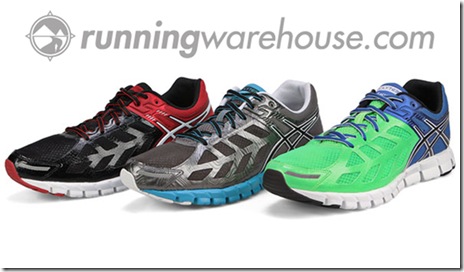
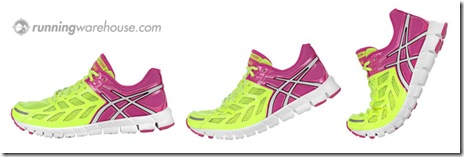
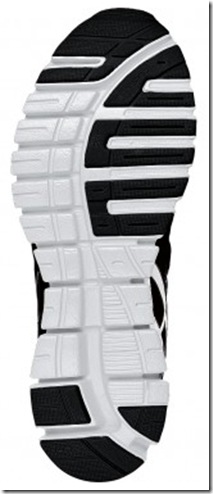
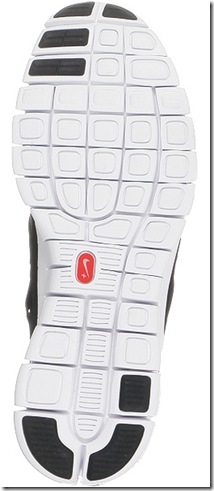


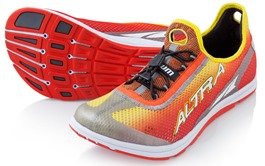
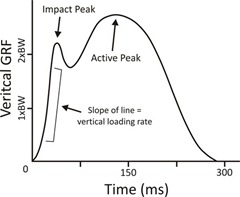
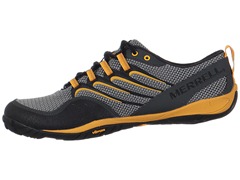














Hi Pete, enjoy reading your blog. I find it odd that Asics are consciously moving into the ‘lightweight’ market when for years they have had an extremely light, relatively low-drop shoe with a toebox wider than many minimal shoes, including the NB minimus: the Hyperspeed 4. It is a racing flat, sure, but with little in the way of arch support and the aforementioned wide toebox, it is a minimal shoe in all but name. If only they made it a little more durable though…
Yes, both the Piranha and Hyperspeed would fit the bill, but racing flats like that are not traditionally marketed to the mainstream runner, where I suspect this one will wind up in malls, sporting goods stores, and specialty running if it does well.
I think one difference between flats and the more minimalist shoes like Nike Free is flexibility of the sole – the Piranha’s have a pretty stiff sole, which for me personally does not agree with my shins :) Interesting to see that the 2nd row of asics pictures are emphasizing flexibility, just like the free run marketing did…
So the amount of cushioning in the two shoes is not relevant? The ASICS Piranha is a lot less cushioned compared to the Frees (type of foams used). This is important as the foam absorbs some of the energy that the ground is transmitting back to you. Less energy absorbed means your body has to absorb the remainder, which for you is being absorbed by the shins. That being said, flexibility plays a role, it’s just that cushioning plays a much bigger role (I think, haven’t tested this in any manner, just applying knowledge I’ve learned from Mechanical Properties of Materials).
Interesting contrast – because Asics is pushing a 10mm heel differential in a new soccer boot dropped earlier this year.
link to soccer.com…
I saw that too. My first thought was Asics makes soccer cleats? My second one was that it was opposite to the approach that most companies are taking in running shoes and not something that most soccer players are even familiar enough with to care about.
Hope Asics isn’t making a big mistake here and increasing the amount of ankle sprains, while trying to reduce achilles injuries. After all, soccer is a sport of fast stops and turns, where stability and proprioception is critical.
This is ironic to me since soccer is what led me to more minimal shoes. I couldn’t figure out why I could play soccer for hours without a problem, but I could barely run a mile before my calves starting screaming. My soccer cleats have little to no drop and three stripes…
Same with American football – I have a football player doing a research project on running form with me and his cleats have no cushion at all. And he’s about 6’5″ and probably 250+ pounds.
the 10mm raise in football boots has been in existance for over 8 years elsewhere in the world. It was actually born in Australia after an extensive needs and injury survey of the crazy sport of Australian Rules Football. Unfortunately.. it has only just hit the market in the USA. The raise was the end product of extensive kinematic, kinetic, EMG and FEM studies, looking specifically at loading of the hamstrings and posterior leg muscles.
For the record.. after 8 odd years.. there has been no avalanche of ankle inversion injuries, but there has been a documented decrease in hamstring injury, including in a professional rugby league team that, extraordinarily, went through an entire season without a single hamstring strain.. coincidence.. maybe.. cannot rely on anecdote, but interesting all the same.
Maybe Lloyd was able to play soccer for hours on end in a soccer boot without injury because the movement patterns are so different.. very multi-directional and spreading the load differently. That is the exact reason I recommend to my runner patients that they spread their training and include trail running, some barefoot on grass, and at least a couple of sessions traing in a less srtuctured shoe.. makes complete sense.
Why is it that non of these companies will put rubber where any lateral mid-foot striker would need rubber?
It seems a bit goofy.
Well, they did say that they lowered the heel to save weight, not to encourage a midfoot strike :)
The brooks pure shoes have carbon rubber pods at the area a mid foot striker lands.
Merrell covers that area well, as does New Balance with the 730 and Minimus Road (MR10 and MR00)
That’s funny, last year Asics came out and said that they didn’ think minimal shoes were anything worthwhile for them to design. Then they threw out that Gel Blur model which was no different than your typical clunky running shoe. Now they’re wanting a slice of the pie?
I wore the GT-2xxx series for many years, but I swore off anything with the Asics brand after those comments they made last year.
what about the hyperspeed? 5mm, 7.??oz and minimal? I think Asics was a frontrunner years agao when they made this. Marketing was toward elite runners. Now with Triathlon and social media other brands beat them to the punch. Hyperspeed is one of my favorites and are right next to my Kinvaras and NB MT10’s!
I think that’s the thing – there’s been a longstanding perception that flats are only for elite or “biomechanically gifted” runners. We’re now seeing more people using flats or moderately minimalist/transitional shoes for at least some amount (or even all) of their regular training. From the standpoint of a shoe company, this shifts how things need to be marketed I think. It’s a difficult path for a shoe company to navigate.
Is there any word about when this shoe will be available?
Nice to hear Asics is jumping on the bandwagon. Could use some more.. attractive… colours though
As much as I dis-liked their comments last year as well, back when I used to run in Asics they were (and probably still are) the most well made, long lasting, high quality shoes I’ve owned. Maybe it helped they were built like a tank, though…If they do enter the zero drop fray I bet they’d be a force to contend with.
Interesting that Asics is now thought of as a latecomer. Twenty years ago Asics was much more into offering
options in this category than most other brands, regardless of how the
shoes were categorized then or now. In the early 90s my mainstays were
some version of Gel Lyte SomethingOrOthers, marketed as lightweight
trainers even though they were lower and lighter than a current Asics
racing shoe, the Tarther. They were more or less current Hyperspeeds but with an outsole that still existed after a couple hundred miles.
I’d love to see Asics reproduce the Onitsuka Tiger Marathon as an actual running rather than retro throwback shoe – bet it would do pretty well in this market.
I feel like these Asics shoes are a bit contrived. Too stubborn to admit there could be benefit to lower profile (dare I use the term minimalist) shoes but too greedy to not want a piece of the pie. Its ‘stubborn marketing’- haha.
I agree about restoring some of their older styles for the new market demand. But hasn’t it been pointed out before that a lot of the lower profile shoes exist in Asian and Japanese markets from Asics already. If they make shoes with lower stack heights and drops for that population why isn’t it suitable elsewhere. Oh yeah, I forgot- we are ‘bigger’ and I am sure couldn’t possibly learn to run in those shoes properly. ;)
Does anybody have any experiences with buying from ASICS Japanese website? They give no info on differential, but the running collection seems very impressive and so different from the shoes made for American market.
“So, new technology now consists of the removal of old technology”
The only reason they call it “new” is to be able to charge the same for old technology with less and simpler materials. At the volumes these shoes are selling now, the economy of scale should make them significantly cheaper than shoes with all sorts of cushions, pillows, bubbles and gels.
Yeah, I immediately thought of the Free Run+ ads when I saw that picture with the sole flexing.
It must cost a lot of money to make old technology disappear :)
Looking at the sole of the Gel Lyte 33, there is a veritable chasm down the center. Nike used this approach in the older Free Run 5.0, and I found that it didn’t take too many miles before the sole started losing its shape, spreading laterally. Unless ASICS is using a more rigid material, they might run into the same issue.
It seems like Asics is pushing their “33” lineup much more now. A year ago, there was only two in that lineup. This new shoe should be interesting and I might consider it over the free (since I get a significant discount on Asics on my college track team).
Another point I found interesting is that they don’t want to say that running on your forefoot makes you faster and less prone to injuries (I believe the second part, since, if you look at sprinters, they rarely have pain due to their biomechanics). A good marketing point would be that people run and train differently, so this is appealing to another crowd.
Cue Simon Bartold! Didn’t he say a little while ago that Asics will never ever make a minimalist shoe? Well I suppose in Asics eyes it isn’t but it is plain to see for everyone else.
Here is an interesting quote from him:
“We’ve not seen a shred of evidence it’s the responsible thing [to lower the heel],” he says. “I am genuinely concerned that we are going to see people getting injured on the basis of a fad that has virtually no foundation in science, that is being flogged and blogged by a whole bunch of people on the internet with absolutely no accountability.”Read more: link to smh.com.au…
I believe he said that minimalist shoes would soon be following in the footsteps of toning shoes :) glad to see Asics irresponsibly lowering the heel on this shoe…
Sent from my iPod
Jeez Pete.. ease up a bit mate. You are commenting on information not released by ASICS and relying on second hand stuff. If you want to know.. why not just ask me, and I will do my best to answer whatever questions you have as honestly as I can.
the Lyte 33 was built with one thing in mind only.. and that is weight reduction. One of the heaviest components is a heel counter.. so we took it out… BUT in its place we used new technology called a heel cluthing system, which I think is better all round, and is used in other non-lightweight category product. the heel cluthing system is a lightweight, highly developed and very expensive system employing a CAD-designed exoskelton of TPU which “grabs” the heel proximally, rather than relying on the very old., probably inefficient and heavy heel counter, which incidentally I believe does not do a hell of a lot anyway, other than offer some integrity to the upper. The Heel cluthing system, I hope, provides better heel fit, grip and support. That certainly is what the FEM’s tell us, as well as wear tester feedback.
You know Pete, we are all in the business of trying to make the difficult business of running as easy and painless as possible. Your blog offers excellent practical information and often fair critiques.
i am offering you whatever information I can give you, whnever you want it. i do not have an agenda, and I like you am only interested in trying to figure out what works best for the enormous variety of runners out there. rather than tryiong to figure out what the running shoes stores may or may not think.. or what a particular running journal says.. you can get up to date info right from the horses mouth.
For the record.. I have never.. NEVER heard of FAST technology.. never been uttered around me.. but then again.. I am not in sales or marketing
best
Simon
Simon,
Promising shoes, horrible marketing. That was the entire point of the post. Thanks for chiming in!
Pete
Loving the Fuji Racer, picked up a pair off RW. Upper is totally spot on, very breathable and can be tightened up quite nicely with even pressure distribution across the whole midfoot. LOTS of room in the forefoot combined with the relatively fitted midfoot is just what I needed.
Other roomy forefoot shoes I liked such as the Altra Instinct were too wide in the midfoot, causing my foot to slide forward on descents. Or the Inov-8 Road-X 233 were too curved inward the forefoot, leaving the big toe practically over the middle of the toe box and the pinky toe cramped. These Fuji’s are actually the shape of my foot.
The wide heel is welcome for a little extra stability, as I tend to be an early stage pronator and a late stage supinator (flat, pidgin foot). Wedges and dual density midsoles don’t work for my knees, overly cushioned shoes generally don’t work for my ankles. These are just right.
Nice low arch on the insole is welcome as well. Really just a great shoe I will use on roads as well as trails. May try on a pair of the Hyperspeed 5’s for roads, if the forefoot is really widened, as it felt quite cramped in the Hyperspeed 4.
Ordered the Fujis. Will cover with GOOP those openimgs at the bottom.. These r not necessary. The hindrance out weights the benefit…
Great review as always Steve. Do you know if Asics still makes the Piranha SP 4? It isn’t listed on their website, and it looks like they have a new minimalist racer, the blazingFAST.